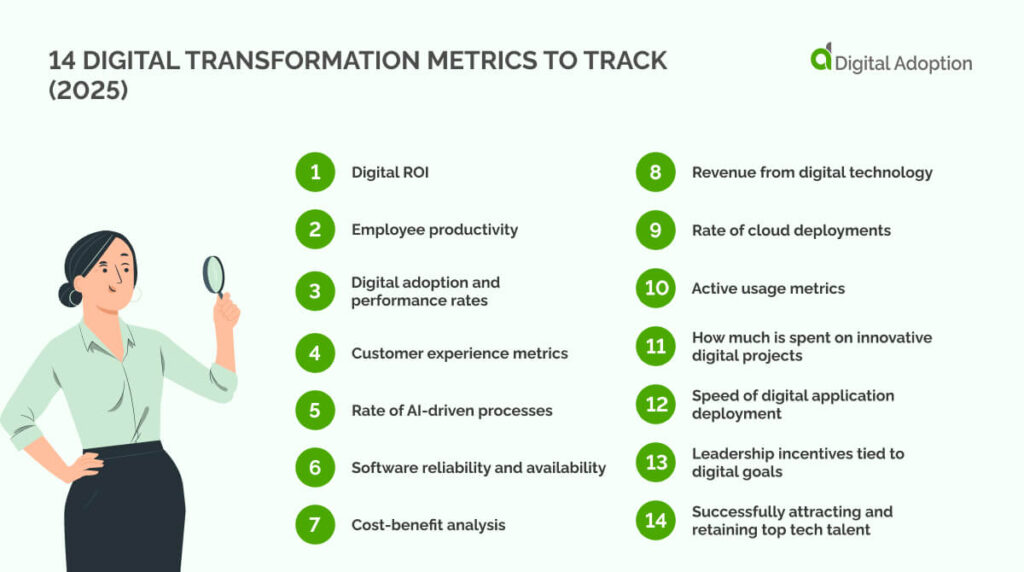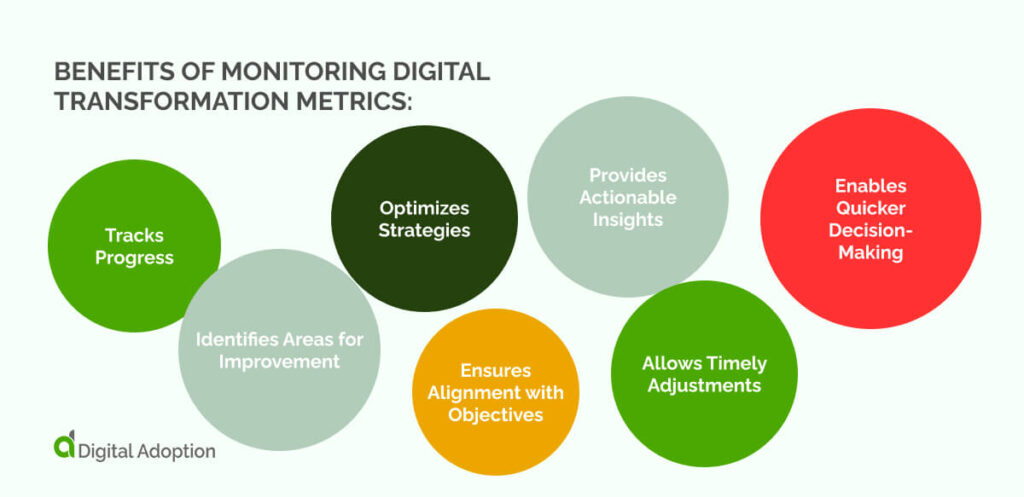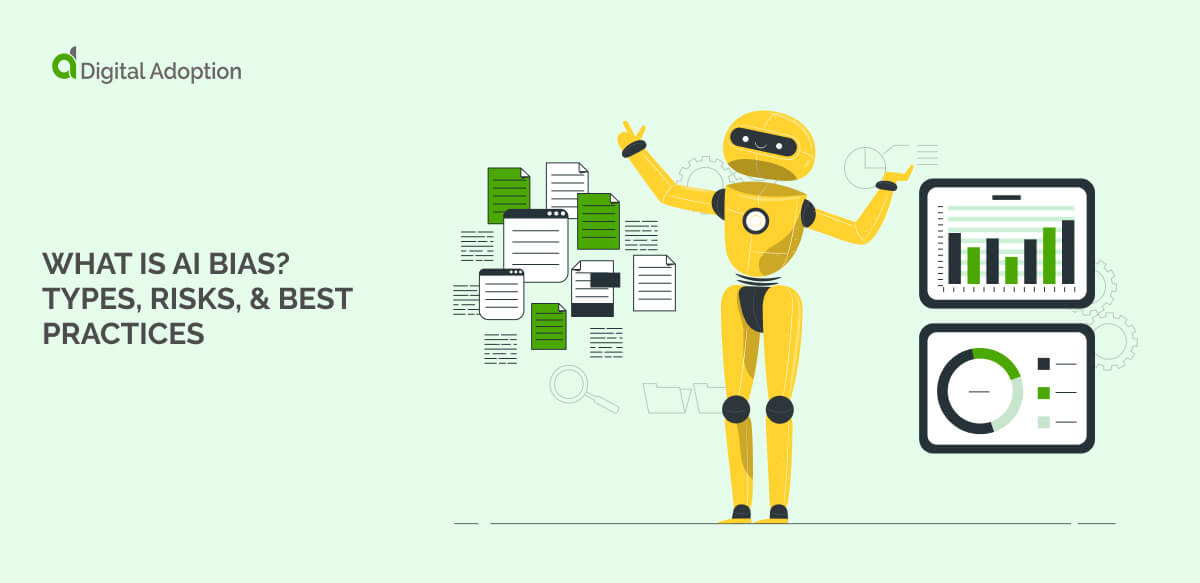When it comes to the digital transformation currently sweeping across sectors, gauging success will differ depending on the business. Each business has distinct goals—improving efficiency, enhancing customer continuity, or driving innovation.
Tracking digital transformation metrics that provide actionable insights is essential for measuring progress. These metrics help leaders assess how well their efforts align with goals, identify areas for improvement, and refine strategies.
As businesses continue their journey toward digital maturity, leveraging these metrics ensures they stay on course.
This article covers fourteen key metrics enterprise leaders should monitor to stay ahead in the digital age and position themselves as first movers in their respective sectors.

- 1. Digital ROI
- 2. Employee productivity
- 3. Digital adoption and performance rates
- 4. Customer experience metrics
- 5. Rate of AI-driven processes
- 6. Software reliability and availability
- 7. Cost-benefit analysis
- 8. Revenue from digital technology
- 9. Rate of cloud deployments
- 10. Active usage metrics
- 11. How much is spent on innovative digital projects
- 12. Speed of digital application deployment
- 13. Leadership incentives tied to digital goals
- 14. Successfully attracting and retaining top tech talent
- How to choose the right metrics to measure digital transformation
- People Also Ask
1. Digital ROI
Digital transformation—as the name suggests, requires a willingness to change and innovate through digital technologies.
As such, smart digital technology investments become a top priority throughout the transformation. Thus, the success of transformations can easily be gauged by observing the return on digital assets.
At their core, targeted investments should directly support priority initiatives, like improving productivity or using AI software to automate tasks.
Track these specific metrics to gauge success:
- Cost-benefit analysis: Compares investment costs against projected gains to determine value.
- Revenue from digital technology: Tracks income generated by specific tools or systems.
- Profit margin: Measures profitability improvements linked to digital adoption.
2. Employee productivity
Another important digital transformation metric business leaders should measure is employee productivity.
For many, improving productivity by introducing new digital tools and processes is part of the transformation agenda. Doing so helps the workforce fast-track their capabilities by using the latest solutions to work smarter, not harder.
However, introducing new technology doesn’t always equate to swift adoption. Measuring the impacts that new tools and processes have on employee KPIs is a key metric to gauge the success of digital transformation initiatives.
Track these specific metrics to gauge success:
- Digital skill assessment: Checks if employees need the skills to use new tools.
- Digital adoption rates: Sees how many employees are using the new tools.
- Error rates: Tracks if mistakes happen less with new processes.
3. Digital adoption and performance rates
We’ve spoken about measuring investments in digital tools and their ability to improve employee productivity, but what if users aren’t adopting these tools well or underperforming?
In this case, measuring digital adoption and tool performance is needed. It’s more than just having tools in place. You must track how well employees use them and how they impact work.
If employees struggle to adopt new tools, it could point to issues like insufficient training, poor usability, or resistance to change. Metrics like active usage rates, task completion times, and employee feedback can reveal whether tools are effective or need adjustments.
Track these specific metrics to gauge success:
- Daily/monthly active users: Shows how frequently employees engage with the tool.
- User adoption rate: Measures how quickly employees start using new tools.
- Average usage time per feature/product: Tracks which features employees use most.
4. Customer experience metrics
These days, customer experiences are expected to be seamless.
How well customers interact with your platform or products is a key indicator of the success of your digital transformation.
If customers find your platform or products difficult to use, your transformation might not work. Measuring customer interaction with your digital services reveals if the changes improve their experience. This feedback helps ensure the right adjustments are made.
Track these specific metrics to gauge success:
- Customer Effort Score (CES): Shows how easy or hard it is for customers to achieve their goals.
- Customer Satisfaction (CSAT): Measures overall satisfaction with your service.
- Net Promoter Score (NPS): Tracks customer loyalty and likelihood of recommending your service.
5. Rate of AI-driven processes
Research shows that the Artificial Intelligence market is projected to reach $243.70 USD billion in 2025, so it’s no surprise that AI is at the forefront of many digital transformation efforts today.
To measure the success of AI adoption in your organization, assess how AI drives efficiencies and improves processes.
Is there a measurable improvement in productivity due to AI automation? How effective are AI-enhanced decisions in delivering the right results?
Track these specific metrics to gauge success:
- Percentage of tasks automated by AI: Tracks AI’s role in automating manual tasks.
- Reduction in process cycle time: Measures how much faster processes are completed due to AI.
- Accuracy rate of AI-driven decisions: Evaluates how accurate AI’s decisions are in business operations.
6. Software reliability and availability
No firm can truly digitally transform with unreliable architecture. A strong-performing and reliable software portfolio is indicative of an agile strategy.
Frequent software errors or downtime disrupt operations. Moreover, a lack of integration with other software leads to silos, which makes work inefficient.
Monitor software reliability to track digital transformation. This will indicate whether the software is supporting business needs.
Track these specific metrics to gauge success:
- Uptime: Measures system availability and reliability.
- Mean time to failure (MTTF): The average time a system operates before failure.
- Mean time to resolve (MTTR): Tracks the time it takes to fix issues and restore services.
7. Cost-benefit analysis
Cost-benefit analysis helps organizations gauge the financial impact of transformation efforts. It paints a comparison between the costs of implementing new technologies and the long-term benefits.
This ensures that businesses invest in solutions that offer the best return. It also helps leaders prioritize which projects are worth pursuing and which may be inefficient.
Understanding the financial implications of digital initiatives allows decision-makers to avoid wasting resources on projects that fail to deliver value down the line.
Track these specific metrics to gauge success:
- Return on Investment (ROI): Compares the financial gain to the investment amount.
- Net Present Value (NPV): Accounts for future returns based on current value.
- Internal Rate of Return (IRR): calculates the rate of return on an investment over time.
8. Revenue from digital technology
Tracking the success of digital transformation efforts involves more than just long-term returns from digital investments. Immediate revenue generated is just as important.
Whether it’s the time saved, software ROI, or revenue from upgraded digital tools, these indicators provide a clear picture of progress.
Measuring how digital technology impacts revenue helps businesses assess the effectiveness of their strategies in real-time.
Track these specific metrics to gauge success:
- Digital revenue growth rate: Measures the increase in revenue from digital sources.
- Digital sales contribution: Tracks the portion of sales from digital channels.
- Average Revenue per User (ARPU): Calculates revenue per customer.
9. Rate of cloud deployments
Today, many businesses rely on the cloud for enterprise architecture due to its scalability and flexibility.
Measuring the rate of cloud deployments helps assess how well a business is adapting to new technologies and driving transformation. If your company still depends on older, legacy infrastructure (such as on-premise servers or outdated systems), it may struggle to keep up with modern cloud migration.
Tracking this metric can show how quickly and effectively your organization is shifting from traditional infrastructure to cloud-based systems.
Track these specific metrics to gauge success:
- Cloud adoption rate: Shows the percentage of your company using cloud technology.
- Percentage of workloads in the cloud: Tracks how many workloads have migrated to the cloud.
- Cloud deployment success rate: Measures how often deployments are successful without errors or delays.
10. Active usage metrics
How actively users engage with your platform shows how well digital efforts work. Metrics like daily active users (DAU) reveal if users are adopting the technology.
A steady or increasing DAU indicates positive usage, while a decline suggests problems. High abandon rates point to issues with the user experience, functionality, or overall appeal. On the other hand, strong conversion rates signal that users are finding value and completing desired actions.
Monitoring these metrics provides a clear picture of how digital initiatives are performing, helping you adjust strategies if needed.
Track these specific metrics to gauge success:
- Daily Active Users (DAU): Tracks the number of unique users interacting with your platform.
- Conversion rates: Measures how many users complete key actions, such as purchases.
- Abandon rates: Shows how many users leave without completing desired tasks.
11. How much is spent on innovative digital projects
Making blanket investments that don’t strategically target specific initiatives is a recipe for failure. In the rush to digitize, companies often purchase tools for every department, hoping for widespread improvement.
However, this lack of direction can lead to wasted resources. To gauge the effectiveness of your digital technology investments, monitor how much of the technology budget is allocated to high-value, strategic initiatives.
Successful digital first-movers focus on achieving specific, measurable goals rather than adopting every new tool.
Track these specific metrics to gauge success:
- Digital innovation spend as a percentage of revenue: Measures the focus on high-value digital initiatives.
- ROI from digital projects: Tracks the return on investments in digital tools and processes.
- R&D investment in digital transformation: Shows how much is spent on innovation and long-term digital growth.
12. Speed of digital application deployment
As we’ve highlighted, digital innovation requires a focused strategy aimed at improving specific areas, not spreading resources too thin. This is a clear example of quality over quantity.
Deploying purpose-built applications that directly address specific challenges is a solid approach to achieving quality outcomes.
The speed at which businesses launch digital applications often signals the success of their transformation. Many organizations struggle to get apps to market quickly, and in some cases, products are outpaced by changes in the market before they’re even launched.
Track these specific metrics to gauge success:
- Time to market for new digital applications: Measures how quickly new applications reach customers after development starts.
- Deployment frequency: Tracks how often new updates or applications are released into production.
- Average development cycle time: Shows the average time to develop and deploy new digital solutions.
13. Leadership incentives tied to digital goals
Tying leadership incentives to digital outcomes helps prioritize transformation.
Take a firm’s chief technology officer (CTO), chief digital officer (CDO), and chief information officer (CIO). If incentives for leaders are dependent on digital goals, they’re more likely to focus on driving real results.
For example, the CTO might earn bonuses for reducing system downtime or speeding up cloud adoption, while the CDO could see rewards for enhancing data accessibility across departments.
Linking incentives to digital targets encourages these leaders to stay committed to measurable results that support transformation.
Track these specific metrics to gauge success:
- Percentage of leaders’ pay linked to digital projects
- Proportion of executives with digital goals in evaluations
- Percentage of leaders receiving bonuses for digital achievements
14. Successfully attracting and retaining top tech talent
Whether or not an organization can attract and retain top talent is a sign of transformative practices and a healthy company culture.
Companies that secure leading industry talent build a foundation for long-term success. As digital efforts evolve, so does the talent needed. Today’s key hires include experts in data analytics, UX design, and application development.
These individuals should be selected to drive change and innovate, not just maintain the status quo.
Track these specific metrics to gauge success:
- Retention rate of tech talent: how long your top hires stay
- Percentage of job offers accepted by top candidates: indicating your appeal
- Time to fill tech roles: measuring recruitment efficiency
- Employee satisfaction and engagement: reflecting the work environment
How to choose the right metrics to measure digital transformation
Choosing the right metrics to monitor will not look the same for each organization undergoing transformation.
Some organizations may be in the early stages, while others are nearing digital transformation maturity and require only minor tweaks to established processes.
To ensure you’re monitoring the right digital transformation metric, consider your organization’s specific goals and current stage in the transformation process.
Identify metrics that align directly with the results you want to achieve, such as improving efficiency, driving innovation, or increasing customer satisfaction.
Avoid generic metrics that don’t offer actionable insights. Focus on those that reflect proven outcomes and reveal the effectiveness of your efforts. This will help maintain direction, measure true progress, and adjust strategies for future success.

People Also Ask
-
How do organizations choose the right metrics for measuring digital transformation?Choosing the right metrics starts with aligning them to specific business goals. Metrics should be relevant to the organization’s current stage of digital transformation and should track progress on core initiatives like revenue growth, user engagement, or operational efficiency. Clear, measurable outcomes help organizations understand where they’re succeeding and where adjustments are needed.
-
What are the benefits of monitoring digital transformation metrics?Monitoring digital transformation metrics helps organizations track progress, optimize strategies, and identify areas for improvement. Regularly reviewing metrics ensures alignment with objectives and provides actionable insights into the effectiveness of new digital initiatives. It also enables quicker decision-making, ensuring timely adjustments when things aren’t working as planned.













